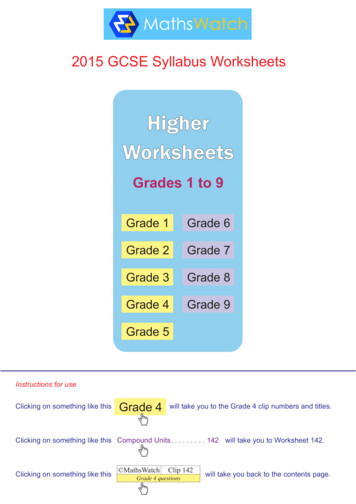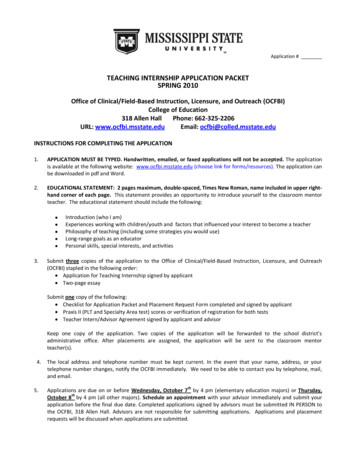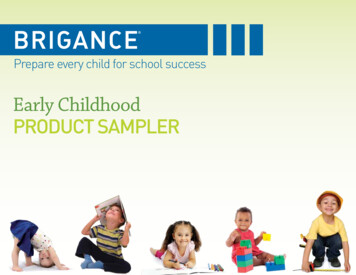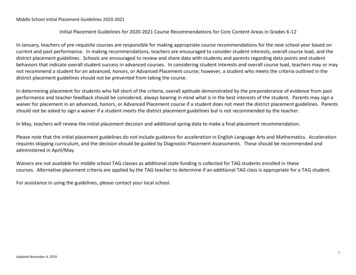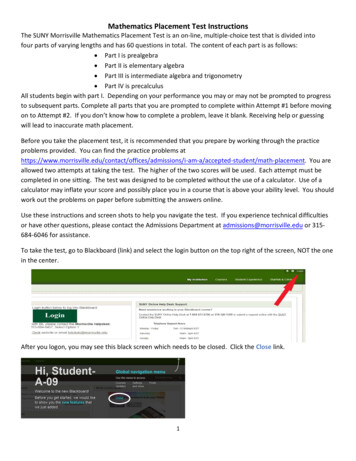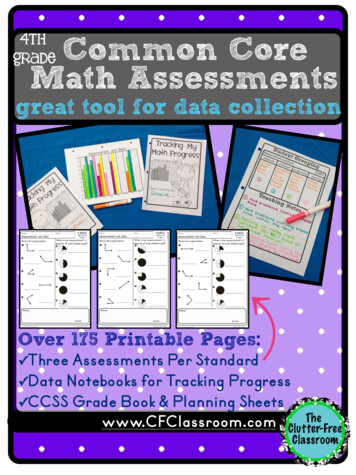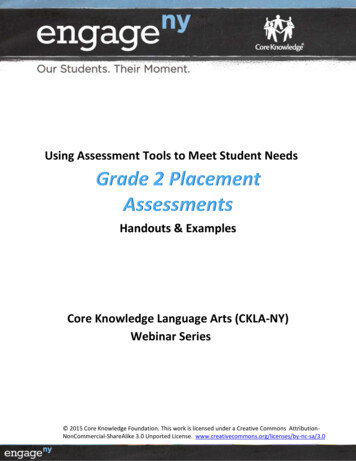
Transcription
Using Assessment Tools to Meet Student NeedsGrade 2 PlacementAssessmentsHandouts & ExamplesCore Knowledge Language Arts (CKLA-NY)Webinar Series 2015 Core Knowledge Foundation. This work is licensed under a Creative Commons AttributionNonCommercial-ShareAlike 3.0 Unported License. www.creativecommons.org/licenses/by-nc-sa/3.0
Table of ContentsPart 1: Preparing for the Placement Testsa. Placement Test Tableb. Placement Test Flow ChartPart 2: Administering the Testsc.d.e.f.Story Reading Assessment, “Snacks,” student dataRachel’s Story Reading Assessment dataEnrique’s Story Reading Assessment dataEnrique’s Word Reading Assessment dataPart 3: Scoring Interpretation and Determining Groupsg.h.i.j.k.Placement Summary Sheet & Interpreting Test Scores SheetAnalysis Chart: “Snacks”Analysis Chart: “Prince Vincent”Analysis Chart: Word Reading AssessmentPlacement and Grouping Guidelines 2015 Core Knowledge Foundation. This work is licensed under a Creative Commons AttributionNonCommercial-ShareAlike 3.0 Unported License. www.creativecommons.org/licenses/by-nc-sa/3.0
Grade 2 Placement TestsTest NameSettingIf the Score is Then the Next Test Will Be Story ReadingGroup5–8Story Reading: “Prince Vincent”0–4Administer Word Reading Assessment5–8Story Reading: “The Beach”0–4Administer Word Reading Assessment5–8Story Reading: “Sink or Float”0–4No further assessmentsN/ANo further assessments“Snacks”Story ReadingGroup“Prince Vincent”Story ReadingGroup“The Beach”Word Reading1-1 2015 Core Knowledge Foundation. This work is licensed under a Creative Commons Attribution-NonCommercial-ShareAlike 3.0 UnportedLicense. www.creativecommons.org/licenses/by-nc-sa/3.03
4Flow Chart for Order of Student Performance Task AssessmentAdminister “Snacks” Story Reading Assessment to entire class.IfStudent scores0–4 on “Snacks”Story ReadingAssessmentStudent scores5–8 on “Snacks”Story ReadingAssessmentAdministerWord ReadingAssessmentAdminister“Prince Vincent”Story ReadingAssessmentStudent scores 0–4on “Prince Vincent”Story ReadingAssessmentStudent scores 5–8on “Prince Vincent”Story ReadingAssessmentAdministerWord ReadingAssessmentAdminister“The Beach”Story ReadingAssessmentStudent scores 0–4on “The Beach”Story ReadingAssessmentStudent scores 5–8on “The Beach”Story ReadingAssessmentAdministerWord ReadingAssessment if timepermitsAdminister“Sink or Float”Story ReadingAssessmentSTOPPlease Note: Cutoff scores on this page are used only to determine which tests to administer during thebeginning of the year. The scores on this page are not used in interpreting Assessment Scores.50Unit 1 Lesson 6 2013 Core Knowledge Foundation
56.1NameSnacksSix kids sat and had a snack.Rob had six fish sticks.Bud had ham.Beth had a bag of chips and a glass of milk.Rich had fish sticks and figs.Jill had a hot dog.Sam had six eggs.Sam got sick.The rest of the kids did not.Unit 1 2013 Core Knowledge Foundation23
6
7
8
9
10
11
12
13
14
15
16
17
18INTERPRETING ASSESSMENT SCORESNote: The scores on this page should not be confused with the scores provided for the administrationof assessments on page 50. Each of the scores in this chart represents a degree of mastery on thecombined assessments administered.If student scores:After Grade 2 Unit 1, instruction should start with:Group7 or more correcton “Sink or Float”Grade 2 Unit 2This student has OUTSTANDING preparationfor Grade 2 Skills.10–4 correct on “Sink or Float;” 6 ormore correct on “The Beach,”and100 or more correct on Word ReadingAssessmentGrade 2 Unit 2This student has STRONG preparationfor Grade 2 Skills.16 or more correct on “The Beach,” 6 ormore correct on “Prince Vincent,”and80–100 correct on Word ReadingAssessment*This student has ADEQUATE and possibly STRONGpreparation for Grade 2 Skills, with good comprehension anddecoding of individual words.Provide targeted small group remediation for the specific lettersound correspondences missed, using selected materials fromthe Grade 2 or Grade 1 Assessment and Remediation Guide.1 or 2*0–4 correct on “The Beach” and 6 ormore correct on “Prince Vincent,”and60–80 correct on Word ReadingAssessment*This student has ADEQUATE and possibly STRONGpreparation for Grade 2 Skills, with good comprehension anddecoding of individual words.Provide targeted small group remediation for the specific lettersound correspondences missed, using selected materials fromthe Grade 2 or Grade 1 Assessment and Remediation Guide.1 or 2*5 or more correct on “Prince Vincent” and5 or more correct on “Snacks,”and60 or more correct on Word ReadingAssessment*This student has somewhat ADEQUATE preparationfor Grade 2 Skills.Provide targeted small group remediation for the specific lettersound correspondences misread on the Reading Words inIsolation Assessment, as well as materials from Grade 2 or Grade 1Assessment and Remediation Guide.2 or 3*0–4 correct on “Prince Vincent” and 5 ormore correct on “Snacks,”and60 or more correct on Word ReadingAssessment*This student has somewhat ADEQUATE preparation for Grade 2Skills.Provide targeted small group remediation for the specific lettersound correspondences misread on the Reading Words inIsolation Assessment, as well as materials from Grade 2 or Grade 1Assessment and Remediation Guide.2 or 3*5 or more correct on “Snacks”and30 or less correct on Word ReadingAssessmentThis student has QUESTIONABLE preparationfor Grade 2 Skills.S/he first needs a comprehensive review of all material from theGrade 2 Unit 1 Assessment and Remediation Guide, before startingCKLA Grade 2 Unit 2. If CKLA Kindergarten and Grade 1 materialsare available, another option may be to use those materials beforestarting CKLA Grade 2 Unit 2.30–4 Correct on “Snacks” and 30 or lesscorrect on Word Reading AssessmentThis student has INADEQUATE preparationfor Grade 2 Skills.S/he first needs a comprehensive review of all material fromthe Grade 1 Assessment and Remediation Guide. If CKLAKindergarten and Grade 1 materials are available, another optionmay be to use those materials before starting CKLA Grade 2 Unit2.IntensiveRemediation*Students scoring in the upper range of words correct may be ready for instruction in the more advancedgrouping, i.e., one instead of two or two instead of three.64Unit 1 Placement 2013 Core Knowledge Foundation
1970STORY READING ANALYSIS CHART:GUIDELINES FOR EVALUATING RESULTSUnit 1 Placement 2013 Core Knowledge FoundationStoryLength & DifficultyCode Knowledge Assumed1.“Snacks”About 50 words Single-letter spellings for“short” vowel sounds,including ‘a’ /a/ (sat), ‘e’ /e/ (egg), ‘o’ /o/ (hot), ‘u’ /u/ (Bud), and ‘i’ /i/ (fish) Single-letter spellings for20 consonant sounds,including ‘b’ /b/ (Beth), ‘d’ /d/ (dog), and ‘f’ /f/ (figs) Double-letter spellingsfor consonant sounds,including ‘ss’ /s/ (glass),‘gg’ /g/ (eggs), ‘ll’ /l/ (Jill)and ‘ck’ /k/ (snack) Digraph spellings forconsonant sounds including‘ch’ /ch/ (chips), ‘sh’ /sh/ (fish), and ‘th’ /th/(the) Some Tricky Words firsttaught in Units 8 and 9 ofKindergarten, e.g., a, of,and the Story is made up entirely ofone-syllable wordsCorrectAnswersNext Steps and Placement Indicated byAssessment Score 5PoorStudent was unable to make sense of a storycomparable to the ones in the Reader for Unit 9 ofKindergarten.Student is NOT READY for the Grade 2 Skills.Student should ideally be regrouped and start at somepoint in the first 8 units of Kindergarten.Use Word Reading scores to guide placement.5BorderlineStudent most likely understood the story, but there isabout a 10% chance of getting a 5 by lucky guessing.Give “Prince Vincent” test and use results forplacement.6–8Adequate–StrongStudent was able to make sense of a storycomparable to the ones in the Reader for Unit 9 ofKindergarten.Give “Prince Vincent” test and use these results forplacement.
202. “PrinceVincent”About 150 words All of the above plus thefollowing: Basic-code spellingsfor “long” vowel soundsincluding ‘ee’ /ee/ (bee),‘a e’ /ae/ (came), ‘o e’ /oe/ (rode), and ‘i e’ /ie/(ride) Basic-code spellingsfor other vowel sounds,including ‘oo’ /oo/(foolish), ‘oo’ /oo/ (look),‘ou’ /ou/ (loud), ‘oi’ /oi/(voice) Basic-code spellings for /er/(after), /ar/ (far), /or/ (north) Spelling alternativesfor consonant sounds,including ‘c’ /s/ (Vincent)and ‘ce’ /s/ (prince) Tricky Words taught in Units1–6 of Grade 1, e.g., once,was, there, from, he, a, said,would, are, and I Past-tense endings with –edas in looked Two-syllable words 5PoorStudent was not able to make sense of a storycomparable to the ones in the Reader for Unit 6 ofGrade 1.Student MAY OR MAY NOT BE READY for the Grade2 sequence.Use Word Reading scores for placement.5BorderlineThe student most likely understood the story, butthere is about a 10% chance of getting a 5 by luckyguessing.If the student also received a borderline score on“Snacks,” administer the Word Reading Assessment.If the student had a good score on “Snacks” butborderline on “Prince Vincent,” give “The Beach” test.6–8Adequate–StrongStudent was able to make sense of a storycomparable to the ones included in the Reader forUnit 6 of Grade 1.Student has ADEQUATE preparation for the Grade 2Skills.You may still want to administer the Word ReadingAssessment, if you have time, to pinpoint specificletter-sound correspondences that need to bereinforced.Unit 1 Placement 2013 Core Knowledge Foundation71
2168WORD READING ANALYSIS CHART:GUIDELINES FOR EVALUATING RESULTSUnit 1 Placement 2013 Core Knowledge FoundationLinesCode Knowledge AssessedCorrectPlacement Guidelines1–3 CVC words with single-letterspellings, e.g., cat, dog, pig Taught in Units 2–5 ofKindergarten Initial and final consonantclusters (CCVC, CVCC, CCVCC) Taught in Unit 6 of Kindergarten Consonant digraphs, e.g., thin,song Double-letter spellings forconsonant sounds, e.g., stuff,rock Taught in Units 7 and 8 ofKindergarten 20 high-frequency Tricky Words Most are introduced in Units 8and 9 of Kindergarten and againin Units 1–4 of Grade 1 Basic code spellings for “long”vowel sounds (like /ae/, /ee/),diphthongs (like /oi/, /ou/), andr-controlled vowels (/er/, /ar/,and /or/), including conventionaldigraph spellings (sweet, shout)and split digraphs (hope, bike) Taught in Units 2–4 of Grade 1 Spelling alternatives forconsonant sounds, including‘tch’ for /ch/, ‘c’ for /s/, ‘g’ for /j/ Taught in Units 5 and 6 ofGrade 111 orfewer outof 15 NOT READY for Grade 2 Skills Needs Intensive Remediation (Grade 2 Assessment andRemediation Guide, Unit 1, or Kindergarten CKLA Unit 3)11 orfewer outof 15 NOT READY for Grade 2 Skills Needs Intensive Remediation (Grade 2 Assessment andRemediation Guide, Unit 1, or Kindergarten CKLA Unit 6) NOT READY for Grade 2 Skills Needs Intensive Remediation (Grade 2 Assessment andRemediation Guide, Unit 1, or Kindergarten CKLA Unit 6)4–67–89 – 1213 – 1516 – 176 or fewerout of 1012 orfewer outof 20 If other word reading is adequate, provide targeted remediationfrom Grade 2 Assessment and Remediation Guide10 orfewer outof 15 Preparation for Grade 2 is QUESTIONABLE, but may beADEQUATE depending on performance in other sections Provide targeted remediation from Grade 2 Assessment andRemediation Guide or Grade 1 CKLA Units 2–4 Closely monitor student progress7 or fewerout of 10 Preparation for Grade 2 is QUESTIONABLE but may beADEQUATE depending on performance in other sections Provide targeted remediation from Grade 2 Assessment andRemediation Guide or Grade 1 CKLA Units 5–6 Closely monitor student progress during Units 1–3 of Grade 2
22Placement and Grouping GuidelinesWe highly recommend that all Grade 2 teachers meet as a grade-levelteam to examine students’ scores across the entire grade level, rather thanhaving each teacher examine only the scores of students in his or her ownclassroom. Homogeneous grouping for Skills instruction is the most efficientand effective way to differentiate instruction and meet students’ needs whenteaching phonics skills. Once the grade-level team has examined the scoresof all students on these assessments, you may find that it makes senseto regroup some students on the basis of their specific decoding skills forpurposes of Skills instruction only.If there is only one classroom teacherper grade level . . . the teacher should start all students in Groups 1 and 2 with CKLAGrade 2, Unit 2, providing individualized remediation in smallgroups using Pausing Point activities and/or the Assessmentand Remediation Guide as needed. Group 3 needs intensiveintervention outside the regular classroom and should not startwith CKLA Grade 2, Unit 2.If there are two classroom teachers pergrade level . . . one teacher provides Skills instruction to all Group 1 and 2students, starting with CKLA Grade 2, Unit 2, while the otherteacher provides Skills instruction to all Group 3 students, startingwith Grade 2, Unit 1 of the Assessment and Remediation Guide.OR . . . one teacher provides Skills instruction to all Group 1students, starting with CKLA Grade 2, Unit 2; the other teachershould provide Skills instruction to all Group 2 students, startingwith CKLA Grade 2, Unit 2; and all Group 3 students, who needintensive intervention outside the regular classroom, wouldnot start with CKLA Grade 2, Unit 2 but rather be provided theneeded intervention.The student scores you have been recording for both assessments will beuseful in deciding where students should be placed for Skills instruction.Once students have been placed and grouped, these scores can be sharedwith other teachers who may be working with students for Skills.(CKLA Skills instruction also includes spelling, grammar, and writing.However, decisions about placement in the CKLA materials are based onevaluating students’ reading (decoding) and basic comprehension skills.)Grade 2 teachers should meet as a team after they have completed thePlacement Planning Chart (having assigned a group number to each studentin their class). Teachers may wish to write each student’s name and groupnumber on an index card for ease in grouping students. Using the groupnumbers, begin sorting students from all classrooms on the basis of theirgroup number, using the following guidelines.If there are three classroom teachers per one teacher provides Skills instruction to all Group 1 students,grade level . . .starting with CKLA Grade 2, Unit 2; another teacher providesSkills instruction to all Group 2 students, starting with CKLAGrade 2, Unit 2; and the third teacher provides Skills instructionto all Group 3 students, who need intensive intervention, startingwith Grade 2, Unit 1 of the Assessment and Remediation Guide.If there are four classroom teachers pergrade level one teacher provides Skills instruction to all Group 1 students,starting with CKLA Grade 2, Unit 2; another teacher providesSkills instruction to the higher-level Group 2 students, startingwith CKLA Grade 2, Unit 2; a third teacher provides Skillsinstruction to the lower-level Group 2 students, starting with CKLAGrade 2, Unit 2; and the fourth teacher provides Skills instructionto all Group 3 students, who need intensive intervention, startingwith the Grade 2, Unit 1 of the Assessment and RemediationGuide.Note to TeacherIf you have access to Grade 1 and/or Kindergarten materials, you mayconsider using those materials in addition to or in lieu of the Grade 2Assessment and Remediation Guide.Unit 1 Placement 2013 Core Knowledge Foundation7374Unit 1 Placement 2013 Core Knowledge Foundation
b. Placement Test Flow Chart Part 2: Administering the Tests c. Story Reading Assessment, "Snacks," student data d. Rachel's Story Reading Assessment data e. Enrique's Story Reading Assessment data f. Enrique's Word Reading Assessment data Part 3: Scoring Interpretation and Determining Groups g. Placement Summary Sheet & Interpreting .


